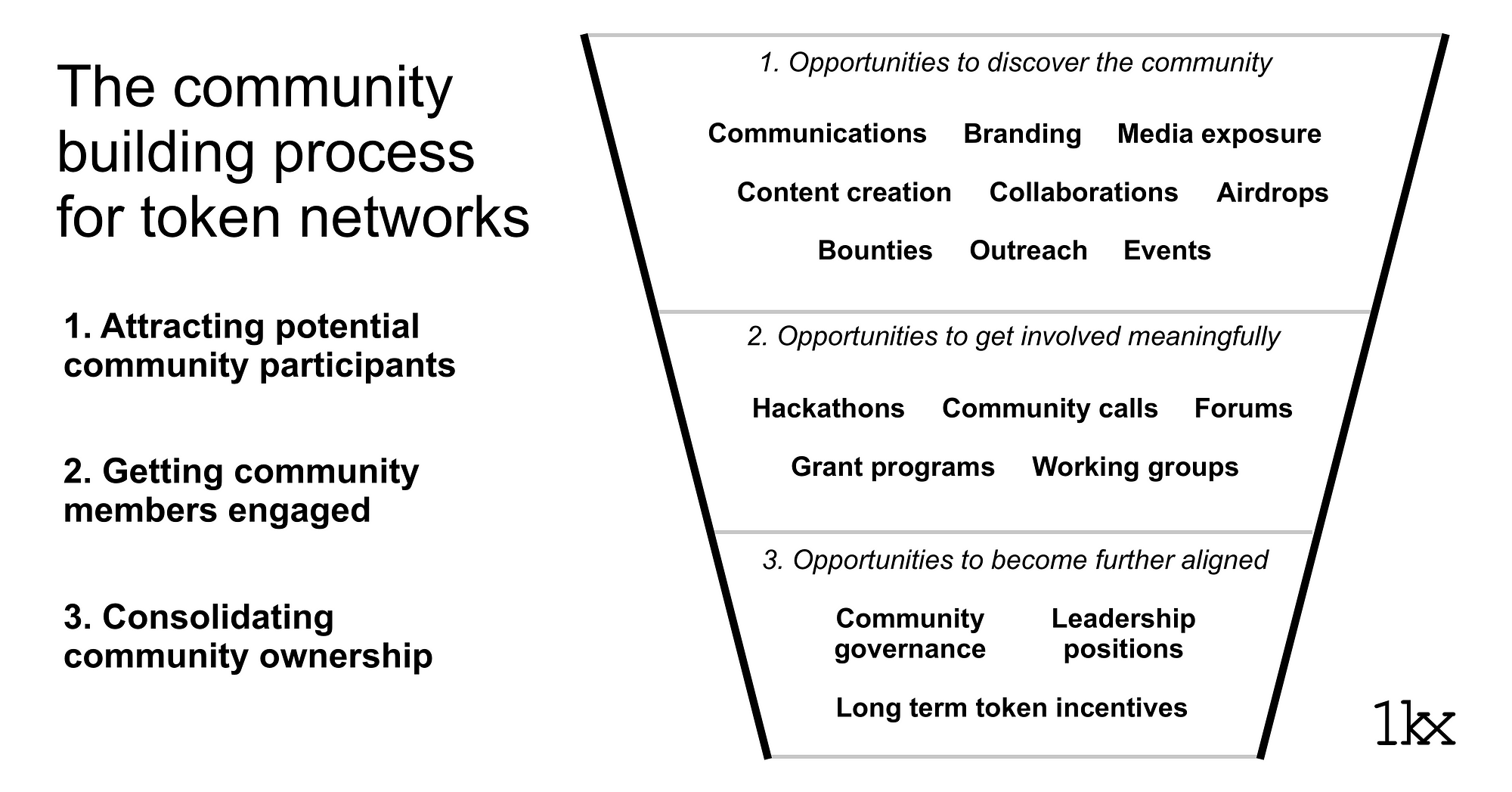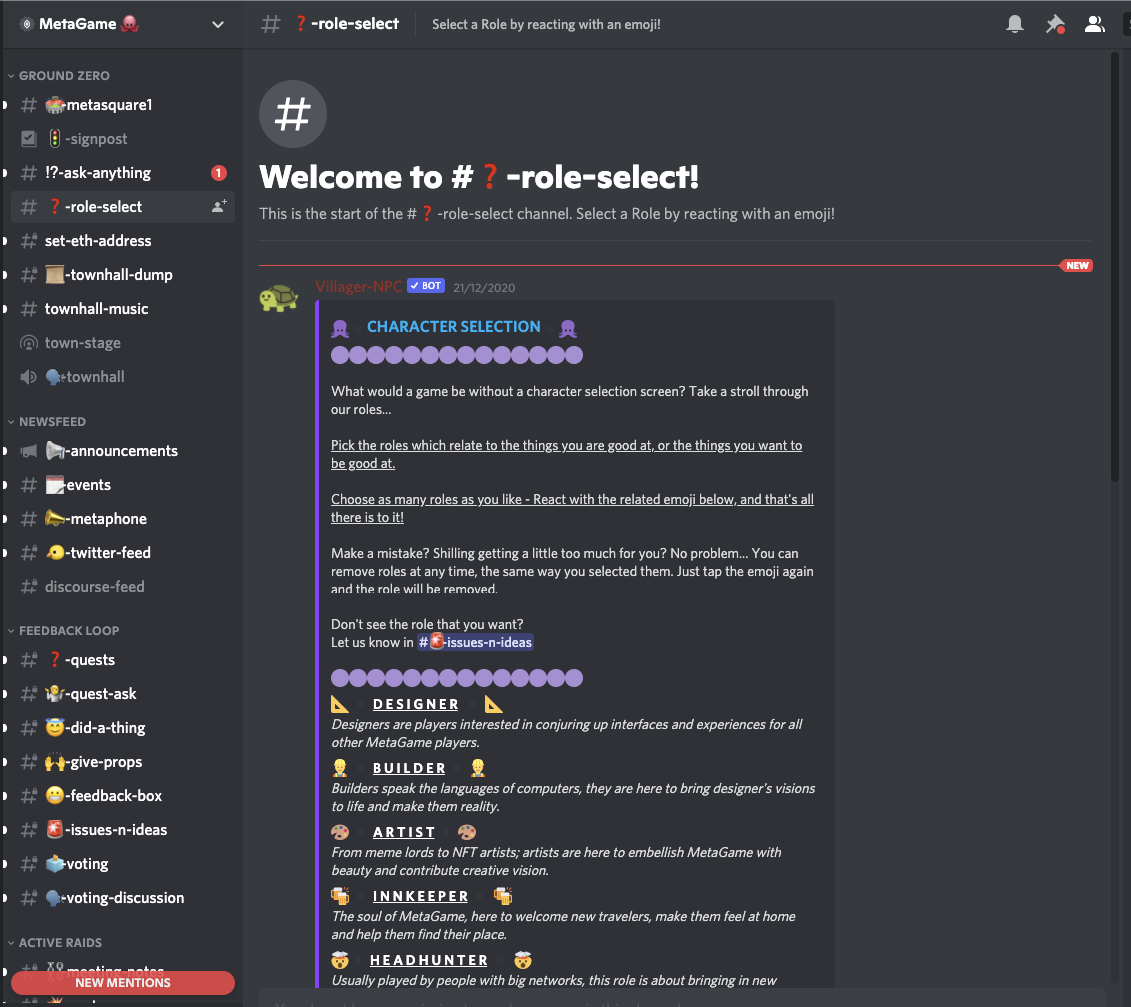标签:decentralized want their community How participants members communities
https://medium.com/1kxnetwork/how-to-grow-decentralized-communities-1bf1044924f8
Decentralized organizations enable work to be distributed to the community members instead of being entirely driven by top-down decision making hierarchies. While tokens financially align participants to contribute value to such a network, it is grassroots community leadership and ownership that enables the long-term success of a token network.
Ownership is not fostered through financial incentive design but rather through a long-term focus on community building. Without a sense of ownership, you will struggle to attract the necessary contributors to decentralize different areas of protocol operations, such as governance and working groups, for your token network.
We can think of the community building process as a 3-stage funnel that takes a potential member from the community discovery stage to sustained positive-sum participation. In building this funnel, community builders should aim to do the following:
- Creating opportunities for people to discover the community/project
- Creating ways for people to get involved meaningfully
- Creating opportunities for participants to build a sense of ownership

1. Creating opportunities for intrinsically motivated contributors to discover the community
Early on with token networks, a large part of your focus should be generating ‘top of the funnel’ awareness to attract community participants.
This work might include:
- Community branding and communications
- Content creation and features in media publications
- Retroactive token distributions and airdrops
- Collaborations and partnerships with other relevant communities
- Community events such as hackathons, panels, and community calls
- 1-on-1 external outreach to potentially relevant potential contributors
Your goal here is to attract primarily intrinsically motivated community members as opposed to purely extrinsic reasons.
- Intrinsically motivated network participants are driven by internalized reasons, such as alignment with the project’s ethos, mission, or even other personal or professional goals. Intrinsically motivated community members form strong communities and sustain their participation even when the monetary upside is uncertain.
- Extrinsically motivated network participants are often driven by external rewards such as financial gain or attention and often optimize for zero-sum short-term self-gain. Extrinsically motivated community members form the basis for weak communities and drive away other, more intrinsically motivated participants. This is especially common in bull markets, where you’ll notice an influx of extrinsically motivated people in your communication channels driven by token price movements.
While people tend to be motivated by various reasons, the goal here is to center the community to attract and retain long-term intrinsically driven participants. Like attracts like, and this applies both ways.
The biggest mistake projects make here is overly focusing their marketing around monetary incentives, such as token liquidity mining programs or price movements, which attracts the attention of mostly extrinsically driven participants.
Instead, focus on creating awareness around what differentiates the community: from how the product was built and designed, ways to participate in the community, the community’s existing contributors, the people behind the project, its mission and values, narratives, memes…
2. Building a relationship with new community members to foster minimum viable contributors
The next goal after attracting community members is to understand what they want to achieve and then guide them towards their own goals to achieve minimum viable participation.
Early on, it is unlikely that new community members are willing to commit a large amount of time or energy without knowing that their efforts will be put to good use. The goal of minimum viable participation is to foster a relationship, from which further trust and engagement can be built.
This process looks like:
1. Community member self-signalling
Investing in building a relationship with every new community newcomer is generally impractical. Instead, you want to focus your efforts selectively on those who want to get involved meaningfully. One way to surface these individuals is to enable people to self signal their intentions.
This can organically emerge through a simple “Introduce yourself” or “I want to contribute” or “what we need” threads/channels where community members can signal their willingness to get involved and express how they want to get involved. This could come in the form of bounties to attract open source contributions or creating structured grants programs catering to developers or specialized network contributors such as liquidity providers, stakers, governance participants, etc.
Eg. Bounties are more useful to those who want to contribute but don’t know how/where to start. Bounties scope out the work to be done and minimize the coordination overhead for those that want to jump straight in.
The key is making sure there are call-to-actions for the different community contributors you are aiming to attract.
Examples:



2. Relationship building and community member success
Once you’ve identified community members who want to participate meaningfully, you want to better understand their goals and needs.
- What brought them to the community in the first place?
- What does their journey into crypto look like?
- Are they aware of different opportunities to get involved?
- Is there anything they are particularly interested in?
- Are they working on anything else themselves?
The goal here is to focus on building a relationship first and only then can you better understand where someone can fit in the community and how the community and help them each their own goals. This can happen through ‘new contributor’ community onboarding calls or even 1-on-1 outreach calls to the most actively engaged community members you identify.
3. Directing community members to opportunities to participate
As you have a better sense of a community member’s level of capacity to contribute and preferences, the next step is to continuously share and create opportunities for them to engage and contribute. As each contributor invests more into the community, you need to match those efforts with relevant positive feedback — whether it may be social recognition, monetary token rewards, or even more responsibility.
You want to think of monetary rewards as a means of acknowledging the value that a community member brings to the community as opposed to being the direct incentive to participate.

3. Fostering community ownership
Everyone wants active community governance from day one, but the reality is that only once community members have grown to become familiar with a community and invested enough of their time and energy, is it possible for them to grow an ownership mentality.
And once you do, much of everything else in between takes care of itself.
Once community members are sufficiently involved with a community, your next goal is to create an environment where community members can safely express their voice and sense of ownership. This may include:
- Being given opportunities to influence and participate in key community discussions, decisions, and forums of importance. The key here is making sure community members feel heard and feel empowered to have a real impact on the future direction of the community.
- Being given opportunities to take on increasingly more responsibility via community leadership roles such as running working groups. eg. Index Coop Biz dev working group, MetaCartel Paladins role
- Being rewarded with vested tokens/network ownership for their work, commitment and value they bring to the community.
eg. Index Coop full time retention proposal
Being able to foster this sense of ownership is key to retaining key community contributors and participants.
There should always be some level of progression on these levels.


Conclusion
We are still in the early days of understanding how to properly build and leverage the capabilities of decentralized organizations to their fullest extent.
Your community is the future of your decentralized network.
If you hadn’t started, the best time to start is today.
Hopefully, this post can help builders get a better sense of how to grow decentralized communities and why community building will establish itself as a core practice of Web 3.0 — if you’re a community builder with more questions, feel free to reach out to ask more questions ~
More about my work at 1kx
I spent much of my waking hours thinking about communities and helping 1kx portfolio projects with their own execution and strategy. At 1kx, we’re focused on investing from Seed to Series A in all areas from DeFi, NFTs, Web3, Social tokens, and all things token networks — we’re proud to have a hands-on approach to supporting our founders. If you are a token network focusing on building community, then please feel free to reach out.
Other relevant posts on community that I’ve written
On hiring and community builders:
Why communities are hard are to build:
On fostering intrinsic participation of communities:
标签:decentralized,want,their,community,How,participants,members,communities 来源: https://www.cnblogs.com/dhcn/p/15788149.html
本站声明: 1. iCode9 技术分享网(下文简称本站)提供的所有内容,仅供技术学习、探讨和分享; 2. 关于本站的所有留言、评论、转载及引用,纯属内容发起人的个人观点,与本站观点和立场无关; 3. 关于本站的所有言论和文字,纯属内容发起人的个人观点,与本站观点和立场无关; 4. 本站文章均是网友提供,不完全保证技术分享内容的完整性、准确性、时效性、风险性和版权归属;如您发现该文章侵犯了您的权益,可联系我们第一时间进行删除; 5. 本站为非盈利性的个人网站,所有内容不会用来进行牟利,也不会利用任何形式的广告来间接获益,纯粹是为了广大技术爱好者提供技术内容和技术思想的分享性交流网站。
